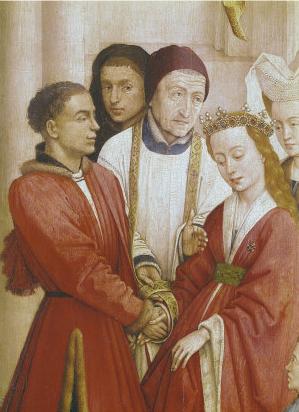
The critical difference between Catholicism and Orthodoxy on marriage is that the latter does not consider Christian matrimony indissoluble. Everything in the administration of the sacrament suggests a permanent union, and all the writing on the subject encourages the people to remain steadfast until death. But the history of Orthodoxy shows that divorce with the right to remarry goes back to at least the sixth century when the Eastern Emperors passed marriage laws without the approval of Rome.
The most significant early legislation is that of Novel XXII in 536 A.D. and Novel CXVII promulgated by Justinian I in 542 A.D. As a matter of record, Justinian accused Pope Vigilius of heresy and asserted that, as emperor, he could pass judgment even on matters of doctrine. Gradually ecclesiastics accepted the civil legislation. The first patriarch to give express canonical sanction to divorce and remarriage seems to have been Alexius, who held office in Constantinople from 1025 to 1043 A.D. Adultery was the only grounds recognized.
Since the fall of Constantinople (1453) a wide range of reasons is available. We get some idea of its scope from the currently acceptable grounds for complete divorce, with the right to remarry, as found in the patriarchates of Constantinople and Moscow – the two largest bodies in Orthodoxy. Twenty-one distinct grounds are listed in Byzantine canon law . . .
In the Moscow Patriarchate there are ten canonical reasons for dissolving the marriage bond . . . The Muscovite legislation on divorce was passed by the national synod summoned just before the fall of the Russian Empire in 1917. Actual promulgation took place the following year. The more extensive Byzantine laws grew out of a millennium of practice but they also date, in their present form, from the 20th century . . .
Provisions are made for marriage ceremonies following a divorce. They are much different from the Crowning at a first nuptial, and reflect a clearly penitential note to emphasize that those who enter on a second union have failed to preserve the purity of their intention . . .
It is of more than historical interest to note that the Trullan Synod [692] was rejected by the Syrian Pope St. Sergius I (687-701); that the synod was held in the throne room (trullus) of the Emperor Justinian II; that the meeting is popularly called the Quinisext, or Fifth-Sixth Council to suggest that it completed the task of the previous two ecumenical assemblies; and that the disciplinary decrees of Trulla served to accentuate the growing division between Western and Eastern marital morality . . .
It was at Trulla that . . . the council also permitted husbands whose wives had been faithless to receive Communion in the Church [Mansi, vol. XI, c. 980]. Without expressly saying that divorce with remarriage was sanctioned, it is presumed that in actual practice no objection was raised.
Until recently, the Orthodox attitude toward contraception was strongly prohibitive. It was assumed that the practice was wrong and writers made only passing reference to the Eastern tradition which universally reprobated the practice. Already at Nicaea (325), men who had castrated themselves were not to be ordained or, if ordained, were to cease functioning as priests [Mansi, vol. II, c. 668]. Chrysostom [Homily on Romans, Patrologia Graeca 60, 626-7], Epiphanius [Panarion, 26], and Cyril of Alexandria [Adoration in Spirit and Truth, 15: PG 68, 690] among the Fathers were cited as witnesses of the Church’s teaching.
Since the first World War, however, more and more writers defend contraception, with marked differences between the Russian and Greek segments. The Russians tend to be more liberal; the Greeks more strict. Thus the Church of Greece has come out against artificial birth control, and the Greek Archdiocese of North and South America has made a similar pronouncement. But even where the prevalent attitude is restrictive, the tendency is to condone contraception.
[As an interesting side note, Fr. Hardon noted that Conservative Judaism came out in favor of contraception in 1934, and Orthodox Judaism — the Rabbinical Alliance of America — gave its sanction in 1958]













